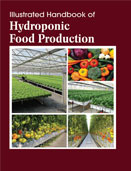Handbooks

This illustrated text is a comprehensive and practical guide to soilless growing, explaining how to operate a hydroponic garden, with detailed instructions, photographs, and step-by-step plans. Hydroponics is a subset of hydroculture, the method of growing plants without soil, using mineral nutrient solutions in a water solvent. Terrestrial plants may be grown with only their roots exposed to the mineral solution, or the roots may be supported by an inert medium, such as perlite or gravel. Growing medium is the material in which the roots of the plant are growing. This covers a vast variety of substances which include Rockwool, perlite, vermiculite, coconut fiber, gravel, sand and many more. The growing medium is an inert substance that doesn?t supply any nutrition to the plants. All the nutrition comes from the nutrient solution (water and fertilizer combined). You can therefore, easily control everything the plants receive. The strength and pH of the nutrient solution is easy to adjust so that the plants receive just the right amount of food. The watering/feeding cycles can be controlled by an inexpensive timer so that the plants get watered on schedule, as needed.
Hydroponics is a technology for growing plants in nutrient solutions (water containing fertilizers) with or without the use of an artificial medium (sand, gravel, vermiculite, rockwool, perlite, peatmoss. coir, or sawdust) to provide mechanical support. Hydroponic gardening is fast becoming a popular choice for many growers around the world due to its more sustainable approach to resource usage than the usual growing methods. By providing constant and readily available nutrition, hydroponics allows plants to grow up to 50% faster than they would in soil. Also, fresh produce can be harvested from a hydroponic garden throughout the year.
Illustrated Handbook of Hydroponic Food Production provides comprehensive information on developing high-yielding, low-input, and quality-oriented systems, offers both physiological and ecological approaches that will help to understand the crop as well as increase its production. Hydroponics eliminates soil and soil-borne pests and disease, so there is no need to use large amounts of pesticides. This, in turn, reduces soil erosion as well as air and water pollution. Pesticides from traditional soil-based agriculture run off into rivers and streams, harming fish populations. Reducing pollution is vital to protecting plants and animals indigenous to areas near farms. Integrated Pest Management, or IPM, is a very common method of insect pest and disease control in hydroponics. Conservation and sustainability are a big part of hydroponic growing. Hydroponic nutrient solutions are recycled in recirculating systems, and can be reused in other garden areas such as potted plants or lawn areas. Many types of grow media can be sterilized and reused in your hydroponic system. Inert media, such as coconut coir, perlite and Growstones, is designed for excellent water absorption as well as air circulation, so they can also be reused in potted plants or soil gardens. Reusing and recycling these products reduces the amount of waste that ends up in landfills. Hydroponics gives hope for food production to areas of the world with poor or infertile soils. This gives populations of people in these areas access to healthy produce. The vegetables grown in these areas, and other places with hydroponic systems, are fresh, delicious and full of flavor- even more so than their soil counterparts. Hydroponics empowers communities that would otherwise not have access to fresh and delicious food. From a scientific perspective, hydroponics is the way to go. Closed, recirculating systems allow for complete control over the nutrient solution so growers are able to know exactly what nutrients their plants receive. Various nutrient formulas are designed specifically to suit different types of plants at different growth stages.
Illustrated Handbook of Hydroponic Food Production focuses on economically important hydroponic food crops, their propagation strategies, plant growth and development, and crop protection. This Handbook will be of valuable to students and researchers interested or involved in the field of Agriculture.